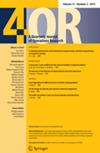Designs of new operating copper processing plants: process types, equipment selection, industry trends
IF 2.6
4区 管理学
Q3 OPERATIONS RESEARCH & MANAGEMENT SCIENCE
引用次数: 1
Abstract
The article describes the largest operating processing plants for lowgrade copper sulphide ores of our time: 10 plants using the semi-autogenous grinding (SAG) technology and 10 plants using high-pressure grinding rolls (HPGR), with the output of 18 to 100 Mtpa. The unfavorable natural and economic factors are balanced by improved ore preparation and concentration technologies and high-capacity equipment units, combined with cost-saving layout solutions. The ore preparation sector is currently divided between the competing technologies of semi-autogenous grinding and HPGR. The article contains an overview of their advantages and disadvantages. The world’s largest monosection with the capacity of 55.5 Mtpa, that uses the SAG technology, is described. The role of the Drop Weght Test JKSimMet (A×b) parameter in the selection of the ore preparation method and the trend for using HPGR in the processing of strong ores are shown. Examples are provided for the consequences of an inadequate assessment of the feed strength in SAG-based plant designs. Examples of ore preparation process intensification through the use of HPGR in semi-autogenous grinding circuits are also given. The volume of impeller flotation cells installed has reached 600 m3. An overview of the two largest processing plants of our time with the output of 88 and 100 Mtpa of ore is presented. The innovative technical solutions of a newest low-capacity copper plant are highlighted. Based on the results of the overview, a future processing plant is predicted to use ∅12.8–13 m SAG mills, HPGRs with the roll diameter of 3 m, vertical VTM-7000 mills in ore grinding cycles, large fine screens, large-scale impeller flotation cells, and staged SFR and DFR flotation reactors.新运营铜加工厂的设计:工艺类型,设备选择,行业趋势
本文描述了目前最大的低品位硫化铜矿石加工厂:10家采用半自磨(SAG)技术的工厂和10家采用高压磨辊(HPGR)的工厂,年产量为18至1亿吨。通过改进的选矿和选矿技术和高容量设备装置,结合节约成本的布置方案,平衡了不利的自然和经济因素。矿石制备领域目前分为半自磨和高压辊磨两种竞争技术。这篇文章概述了它们的优缺点。介绍了采用SAG技术的世界上最大的单节井,产能为5550万吨/年。指出了降重试验JKSimMet (A×b)参数在选矿方法中的作用,以及高压辊磨法在强矿石加工中的应用趋势。举例说明了在基于sagg的工厂设计中对进料强度评估不充分的后果。文中还给出了在半自磨回路中利用高压辊磨强化选矿工艺的实例。安装的叶轮浮选池体积已达600 m3。概述了我们这个时代的两个最大的加工厂,产量分别为88和100万吨矿石。重点介绍了一家最新的低产能铜厂的创新技术解决方案。根据概述结果,预计未来某选矿厂将采用∅12.8-13 m SAG磨机、辊径3 m hpgr、磨矿循环立式VTM-7000磨机、大型细筛、大型叶轮浮选池、分级SFR和DFR浮选反应器。
本文章由计算机程序翻译,如有差异,请以英文原文为准。
求助全文
约1分钟内获得全文
求助全文
来源期刊

4or-A Quarterly Journal of Operations Research
管理科学-运筹学与管理科学
CiteScore
3.80
自引率
5.00%
发文量
26
审稿时长
6 months
期刊介绍:
4OR - A Quarterly Journal of Operations Research is jointly published by the Belgian, French and Italian Operations Research Societies. It publishes high quality scientific papers on the theory and applications of Operations Research. It is distributed to all individual members of the participating societies.
 求助内容:
求助内容: 应助结果提醒方式:
应助结果提醒方式:


